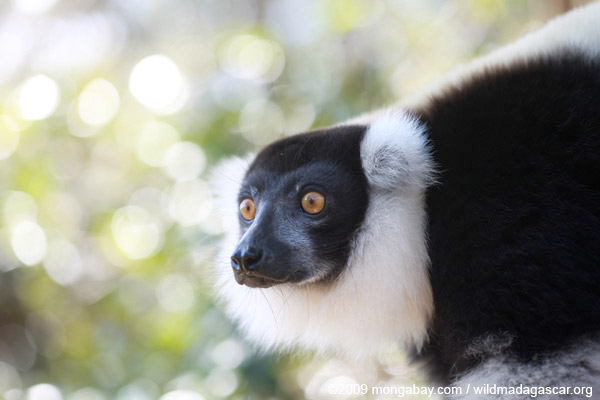Authors note: although reported on in 2011, the lemur breeding as described below occurred in 2001.
After years of releasing captive-born lemurs into the wild, the Madagascar Fauna Group (MFG) has finally succeeded in breeding a captive-born black-and-white ruffed lemur female with a wild male, a pairing that in October 2001 produced twins in Betampona Natural Reserve. This is a milestone for lemur conservation, since it is the first time a captive-born lemur and a wild lemur have successfully mated and given birth.
“[The captive-born female] disappeared in late October [2001], though the conservation agents knew from her radio collar signal that she was hidden from view high in the treetops. Then in the first week of November first one infant then both infants were observed as she moved them about. Both infants continue to look strong and healthy,” Charlie Welch, the technical adviser who headed up the MFG in Madagascar in 2002 said in a press release from Durrell Wildlife Conservation Trust, a founding member of MFG.
Surrounded by rice fields, Betampona Natural Reserve’s lemur population is isolated from other groups. Conservationists hope that by introducing captive-born lemurs into the community they can retain genetically healthy individuals
“Without this project, the Betampona population of ruffed lemurs was calculated to become extinct from the negative consequences of inbreeding within 100 years or less,” explains MFG chief of staff from 2002, Dr. Eva Sargent.
Monty Python actor, lemur-lover, and longtime supporter of the MFG, John Cleese cracks that if the lemurs become too inbred “they would get like the British Upper Class. And I wouldn’t want that to happen to these creatures!”
The black-and-white ruffed lemur is listed as Critically Endangered by the IUCN Red List. It is threatened by deforestation, including from slash-and-burn agriculture, logging and mining. They are also illegally hunted.

A black-and-white ruffed lemur. Photo by: Rhett A. Butler.
Related articles
Lemur poaching continues in Madagascar [warning: graphic pictures]
(01/03/2011) A lemur poacher was intercepted with 32 dead lemurs on New Year’s Eve in Madagascar’s northeastern town of Vohemar, suggesting that killing of lemurs for the commercial bushmeat trade continues on the island nation, reports Fanamby, a Madagascar-based conservation group.
Picture: New lemur in Madagascar
(12/15/2010) Researchers have discovered a new species of lemur in Madagascar.
Extensive logging, lemur hunting in Madagascar national park despite moratorium

(11/16/2010) A biological survey in Northeastern Madagascar has turned up evidence of extensive logging in Masoala National Park, a UNESCO World Heritage Site renowned for its biologically-rich rainforest. The findings suggest that harvesting of valuable hardwoods—including rosewood, ebony, and palissander—continues despite an official ban on the logging and export of timber.